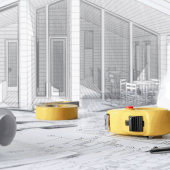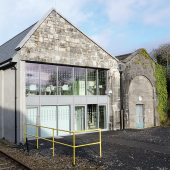Future proofing housing for OAPs

Is technology in older people’s housing an afterthought? The Housing, Learning and Improvement Network is trying to ensure no one is left behind
Buried on page 226 of the government’s recent Levelling Up the United Kingdom white paper is an important announcement: a new taskforce is soon to be launched “to look at ways better choice, quality and security of housing for older people can be provided. For older people trapped in non-decent or unsuitable accommodation, the UK Government will work to increase the choices available to them.”
The pledge is welcome news for Jeremy Porteus, Chief Executive of the Housing, Learning and Improvement Network (Housing LIN), who is only too aware that providing better and more suitable housing provision can enable people to live more independently for longer.
Housing LIN has been pushing for such a taskforce for some time, citing the need for government to tackle issues of design quality, service quality and supply of housing for older people, and to make all housing more adaptable.
By 2030, one in five people in the UK will be aged 65 or older. But society is failing to keep pace with the types of homes best suited to them. “While 10% of housing in Australia is designed for the older population, and 17% in USA, in the UK it’s about 5%,” Jeremy points out. What’s more, half of the specialist housing we have was built more than 30 years ago and much is no longer fit for purpose in a digital age without extensive renovation.
And there’s another lost opportunity too: while technology has advanced in leaps and bounds over the past decade, this is not being harnessed to create smart living environments that can enrich the lives of older and disabled people, Jeremy says.
Up to date
The practical adoption of connected technology and how housing can be wired for its use is the subject of Housing LIN’s latest enquiry: Technology for our Ageing Population: Panel for Innovation (TAPPI). The TAPPI panel interviewed 30 experts and consumers over six months before publishing its recommendations in October 2021. It called for any project across the housing, health and/or adult social care sectors to incorporate a tech strategy so that older residents are not digitally excluded.
Jeremy is hoping TAPPI will have the same effect on housing as its 2009 report, Housing our Ageing Population: Panel for Innovation (HAPPI), which provided the design blueprint for the majority of new housing for older people built over the past decade or so.
Housing developments harnessing HAPPI principles are full of daylight, both in the homes and in shared spaces. They also incorporate balconies or other outdoor space, and have shared gardens with plants and trees. Though these elements seem nothing out of the ordinary in what we might expect of new homes, they were often missing in older persons’ dwellings.
The TAPPI panel drew up ten key principles for new housing. Included in these are: all housing should be able to adapt to meet changing user needs and technological advances; digital, health and income inequalities should be reduced to enable active involvement in home, local community or networks; health and wellbeing should be improved to raise quality of life or maintain independence; and people must be empowered to co-create solutions to how they want to live their lives.
Jeremy points out that Covid-19 has accelerated how society is using technology to communicate, connect and experience health and care support. But it is now paramount that older generations are not left behind.
These aims are supported in the white paper, where digital equality is a key strand, and also dovetails with the sentiments set out in the People at the Heart of Care: Adult Social Care Reform white paper published in December. The social care white paper’s vision is to embed housing as part of the local health and care system, make it easier for people to adapt their home so they can live independently and safely for as long as possible. It also calls for an increase in the supply of specialist housing; £210m has been allocated to help.
TAPPI recommendations
The TAPPI report makes a number of recommendations that would see widespread use of technology in new housing design and construction, as well as upgrading and adapting existing housing. These include:
- establishing a clear minimum digital living standard that works as a benchmark alongside industry codes and charters, setting out what is needed to live well and safely in a digital society
- as part of a national digital strategy for transformation, create a housing, care products and services marketplace platform that will enable easy consumer access to relevant digital products and services
- review and update planning policy and guidance as well as the regulatory framework for housing so that smart technology infrastructure is built into new homes, making them adaptable to the needs of an ageing population; and
- futureproof government guidance on Disabled Facilities Grants so the scheme supports retrofitting and adaptations of homes for an ageing population with a new Technology Facilities Grant.
The report also highlights a number of projects where technology is being used to help residents. One of these has been trialled by the Innovate Trust, which has developed smart houses that provide a test bed for how mainstream technologies can be used to support people with learning disabilities. They have incorporated a variety of affordable mainstream consumer technology, from voice/video-activated devices to others controlled using gestures, while also using the Internet of Things. Research found that people’s health and wellbeing improved when using these mainstream technologies to support their daily living.
Jeremy says that making homes more adaptable might mean having to install future-proof cabling, interoperable tech platforms and multiple power supplies or adaptors. He wants to explore how this could be accommodated in off-site homes, which could be designed and manufactured in a way to incorporate technology later, such as fully electric hoists or sensors.
“Whatever the spec, by hard-wiring digital into homes, people can connect the gadgets they want to use. And as someone’s needs change and technology advances, their home adapts too, supporting not only the latest mainstream consumer devices but more specialist telecare or telehealth systems,” he says.
The report suggests TAPPI provides a benchmark that should encourage the housing sector to apply the panel’s principles when designing, developing, managing or marketing homes.
The next phase of the work will be launched at the TEC Services Association’s International Technology Enabled Care conference in Birmingham this month and will set out plans to develop the TAPPI framework. This includes receiving bids to recruit live test beds across up to four localities. Successful schemes will win a share of funding from sponsors the Dunhill Medical Trust.
“My ask,” says Jeremy, “is that all housing is digitally accessible, it can accommodate the future needs of residents and is care-ready, and that strong partnerships across housing, health and social care are forged. This will be vital to support our ageing population – and the levelling up agenda.”
Find out more at housinglin.org.uk
Read the TAPPI report at bit.ly/TAPPIreport
View the HAPPI report at bit.ly/HAPPIreport
Read the social care white paper at bit.ly/SocialCareWP







